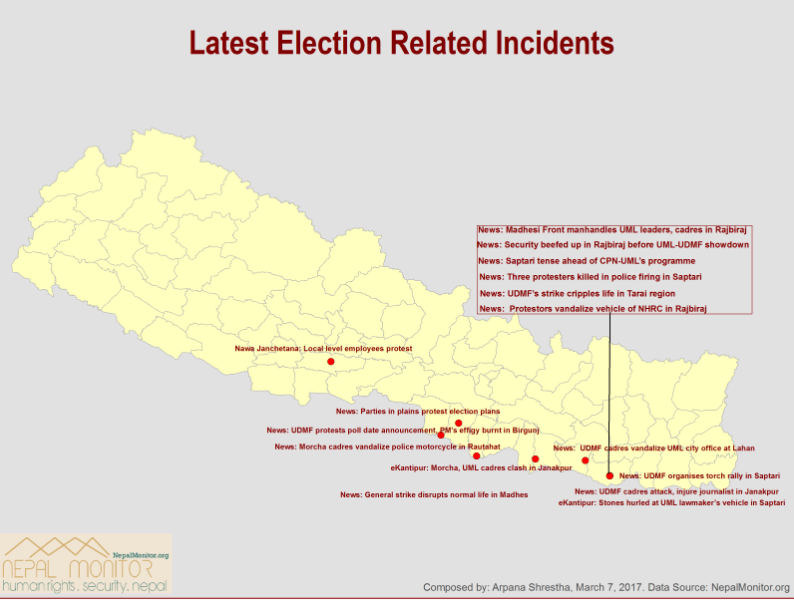Analysis
Electoral Violence Monitoring and Mitigation
2017-03-13

On March 7, 2017, COCAP | NepalMonitor.org organized an interaction program with representatives of the electoral community in Nepal. During the program, NepalMonitor.org introduced its plan for electoral violence monitoring during the upcoming local election and discussed how participants can utilize the platform and dataset for their own observation and violence mitigation work. The NepalMonitor team also presented preliminary data on violence and contestations following the announcement of the election. The program followed a day after the tragic incident in Maleth Saptari, in which 5 people died in police firing. The level of engagement from participants was encouraging.
Context
On February 20, 2017, the Government of Nepal (GoN) announced the date for local election to be held on May 14, 2017. This election – the first to be held for local bodies in Nepal since 20 years – is part of a series of 3 elections mandated under the new constitution to be held on local, provincial, and national level by January 2018. The announcement was opposed by the United Democratic Madhesi Front (UDMF) who demanded, amongst others things, the resolution of the dispute over local and provincial boundary delineation first. Since then, protests and campaigns have been organized in the Terai demanding constitutional amendments before the elections. Tensions further increased with the commencement of Communist Party of Nepal (CPN)-United Marxist Leninist (UML) “Mechi-Mahakali National Campaign” on March 3, 2017. Because of CPN-UML’s expressed opposition to the constitutional amendment, UDMF vowed to disrupt the campaign and warned the CPN-UML not to proceed with its mass gatherings in the proposed province No. 2.
The situation escalated on March 6, 2017, when three persons died in Maleth of Saptari district as a result of police firing following a clash between them and the protesters of the UDMF, near the venue of a mass meeting of the CPN-UML. According to first reports, eight people sustained bullet injuries of whom two succumbed to their injuries in the following days. Following the death of protesters, tension increased in the region. Protesters vandalized police vehicles, organized strikes, set fire at the Armed Police Force (APF) check-post and hurdled petrol bombs at the Rastriya Banijya Bank which led to an indefinite curfew in the district headquarters of Rajbiraj and adjoining areas. Protester also attacked an office of a Local Peace Committee, District Forest Office, Rajbiraj Municipality and a vehicle of the National Human Rights Commission.
The increased tension in the Terai has disrupted the daily lives of many and caused numerous incidents of violence with civil society organizations, including COCAP, Himrights and THRD Alliance, amongst other, expressing their concern. The Terai Human Rights Defenders Alliance (THRD), has urged national and international stakeholders including Human Rights agencies and members of the International Community to persuade CPN- UML and UDMF leaders to avoid violent situations in Terai. The International community has also reacted with shock to the violence in Saptari district. The United Nations (UN) in Nepal has called on security forces to comply with existing national and international standards on the use of force and urged the political parties to peacefully express their views in action and statements. Amnesty International has urged Nepal’s authorities to promptly investigate the security forces who opened fired on a crowd of protesters in Saptari.
Peace Monitoring System
Since August 2016, NepalMonitor.org has been recording detailed variables of violent and non-violent events which include physical violence, political contestations, strikes and other protests under its new Peace Monitoring Project. For each event, form, cause and impacts are recorded. The system is designed to allow for longer-term trend analyses of violent incidents and has now been adjusted to monitor electoral violence more effectively and record a larger number of reports in context of the upcoming local elections. NepalMonitor.org will also be publishing regular updates and collaborate with Democracy Resource Center-Nepal to publish analytical reports.
The graphs below were presented at the interaction program and map incidents in the context of the announcement of local elections up to March 6, 2017.
See also our entry on this blog on how to use NepalMonitor.org’s website to access, filter, and export latest reports.
To get an updated list of reports related to local elections and constitution election please click here.
To subscribe to reports by email or SMS, please click here.

